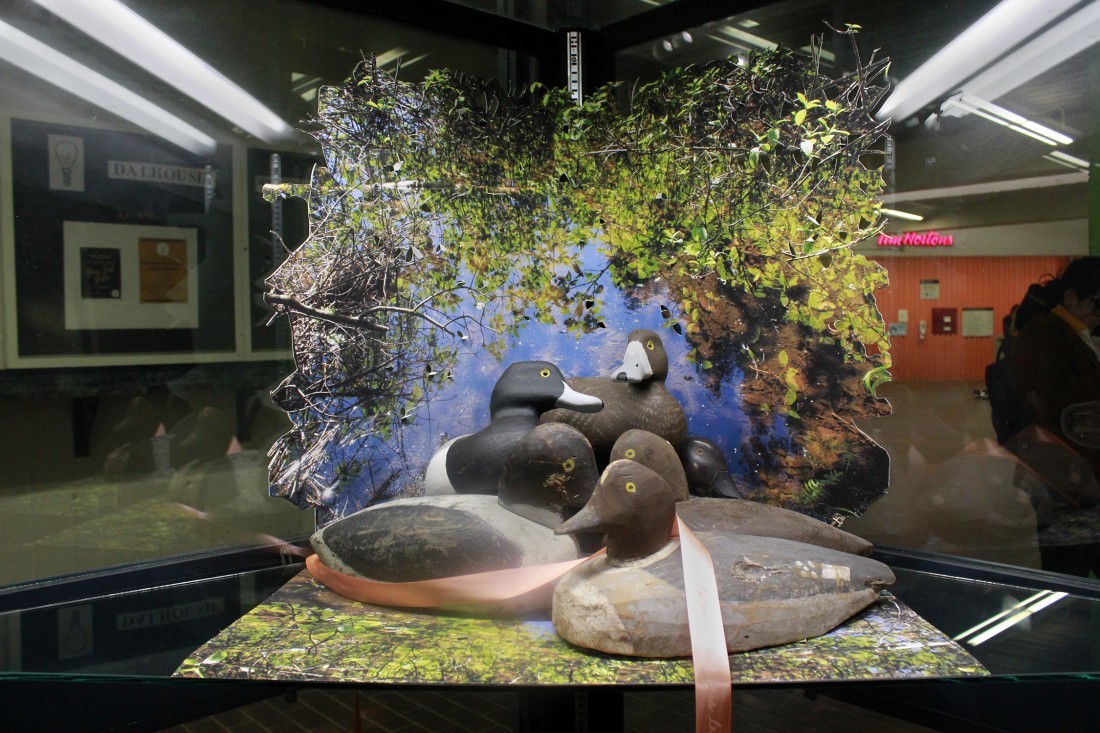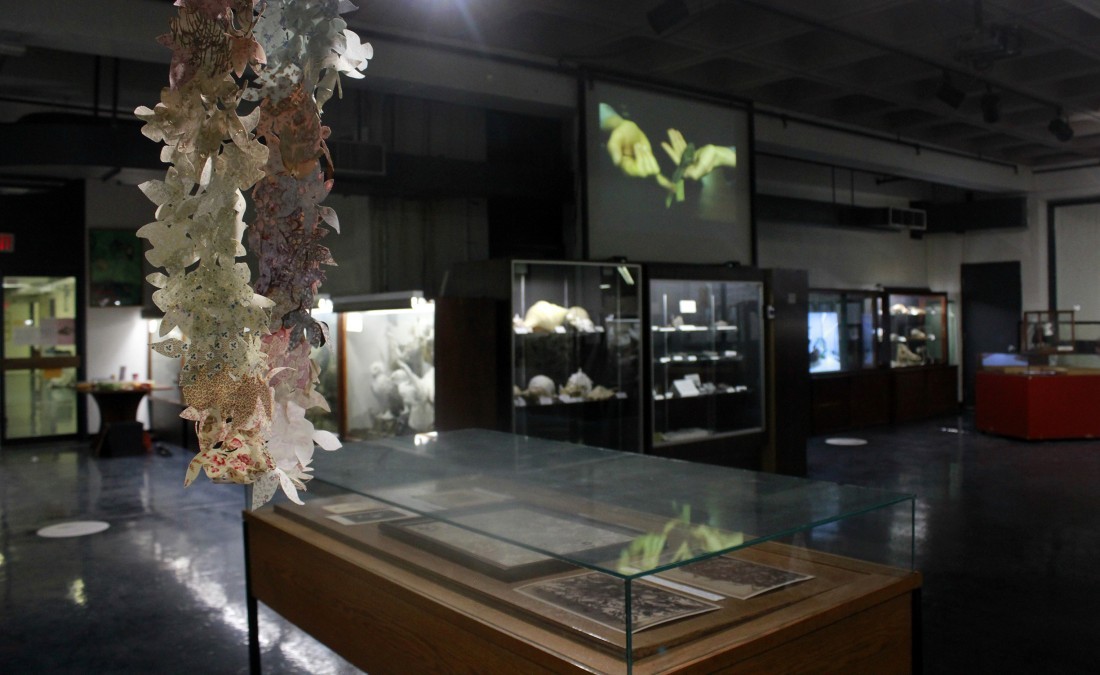“The Impossible Museum”
D’Arcy Wilson and Amy Malbeuf
The Thomas McCulloch Museum is tucked away in one of the many brutalist buildings from the late 1960s and early 1970s that make up the stolid core of Dalhousie University. The collection, however, dates back much earlier, to the early 19th century when natural scientist and minister Thomas McCulloch moved to Halifax as the first principal of Dalhousie College. He brought with him a collection of taxidermied birds, collected and mounted by himself and his son, another Thomas. Both Thomases were colleagues of John James Audubon, and they collected many local species at the behest of the more famous naturalist. McCulloch, who tried without success to interest the province of Nova Scotia in buying his collection, eventually left the birds to Dalhousie. For 87 years the collection was stored in various hallways and basements, considered a resource for students of biology. In 1971 the decision was made to collect the specimens together into one site, carved out of a vast lobby space in the new Life Sciences Building, home to the Department of Biology, amongst others.
The museum was created by stringing glass walls along the support beams of the building itself, creating a small space that has windows on three of its four sides. Whether the irony was intentional or not, the museum created to house vitrines is itself a vitrine. Whatever the original intention, that irony was not lost on Lisa Bouraly, a curator doing a residency at Eyelevel Artist Run Centre. In a talk she described the museum as “one large diorama.” That is an apt description, as the large glass walls of the museum make it open to the scrutiny of the passers-by in what is a busy passage through a busy building. Through the windows you can see into the cases, most of which contain McCulloch’s birds, though other collections gathered over the decades are also present (a large collection of colourful ceramic mushrooms by potters Alma and Ernest Lorenzen, skulls and skeletons, massive pieces of coral and preserved insects from around the world). It is a museum without a curator or mandate, an expanded cabinet of curiosities maintained by a technician who has numerous other responsibilities throughout the department.

“The Impossible Museum: D’Arcy Wilson and Amy Malbeuf,” D’Arcy Wilson, Handiwork, 2020, 10 decoys from the Thomas McCulloch Collection (Dr Bill Freedman’s donation), dimensions variable. Images courtesy Eyelevel Artist Run Centre & Bookstore, Thomas McCulloch Museum, Dalhousie University, Halifax.
An anachronism, then, though one not without its charm (or oppressiveness, depending on your point of view). The curator invited D’Arcy Wilson and Amy Malbeuf to respond to this very particular space, imbued with what Bouraly describes as “material vestiges of the British Empire.”
Wilson, whose ongoing project The Memorialist was featured at an exhibit at Dalhousie Art Gallery last year, has made a particular study of natural history museums and the practice of collecting animal specimens for display. The series is comprised of performance documentation, photographs, drawings and video projections, along with interventions into museum spaces. Wilson has visited many of the museums that were supplied with North American specimens by Andrew Downs, the founder of a Halifax zoological park (the first in North America) and a taxidermist. Active in the mid-18th century, he was a contemporary of both McCullochs.
In her contribution to the “The Impossible Museum,” Wilson decided to interject drawings into the displays, creating colourful garlands and sprays of flowers out of paper to adorn certain vitrines and specimens. These delicate watercolours are based on the vegetation in the cabinets, accompanying the various raptors, shorebirds and other native Nova Scotia bird species on display. One large stuffed Canada goose, which hangs from the ceiling of the museum (and has presumably done so since 1971), is posed as if it is descending to the ground after flight. A long floral garland made from laser-cut flowers adorns this “snowbird,” a reminder, perhaps, of its time in sunnier southern climes. A video projection featuring excerpts from three of Wilson’s Memorialist videos plays in the space. Wilson also did research on McCulloch birds, visiting the Canadian Museum of Nature to place a drawing in the case holding an example of the now-extinct Labrador Duck, a permanent loan to the Museum of Nature from Dalhousie, due to the extreme rarity of the Labrador Duck specimen. In an otherwise empty vitrine, Wilson has displayed a backlit photograph of the duck in its new habitat, a rare specimens vault, in Ottawa. Wilson, who now lives in Corner Brook, where she teaches at Memorial University’s Grenfell Campus, has included a hooked rug in the exhibition (a nod to both her family history and the famous Grenfell Mission hooked rugs).

“The Impossible Museum: D’Arcy Wilson and Amy Malbeuf,” installation view.
Amy Malbeuf, who is Métis from Rich Lake, Alberta, and now living in Halifax, has turned the entire museum into a vitrine, displaying six works in the windows, stretched across the plate glass with webs of bright yellow rope. Coyote, rabbit, fox, muskrat, skunk, beaver, 2014, is displayed so the fur side of the pelt faces outside the museum. She has sewn safety vest material on the skin side, a poetic and effective reminder of the precarity of the natural world in these post-industrial times. One need only think of the ubiquity of roadkill carcasses along our highways to see the irony of these skins, especially in their setting in this strange cabinet of curiosities. Of course, First Nations people and their cultures were long as much an object of study by scientists of various stripes as were the animals with which Indigenous peoples cohabited this land. Natural scientists, through their collecting, studied their subjects to death, as did anthropologists, missionaries, medical workers, teachers and other, less purportedly altruistic, colonists. Given Canada’s shocking history of treatment of Indigenous peoples, the safety vests on these pelts (furs being the first major trade goods between the original inhabitants and the newcomers) take on a more ominous cast.
Malbeuf often incorporates objects inherited from her family in her work, as she has in Stretch, two wooden coyote pelt stretchers that were originally her grandfather’s. These long boards are topped by rabbit skins printed with zebra stripes and leopard spots. She purchased the furs for this piece from the same Edmonton store that once bought pelts from her grandfather. And again, this meditation on her family’s (and her people’s) relationship to the land and its other inhabitants is all the more pointed in this setting. The simplest, yet most moving, work in the exhibition replaces a portrait of Thomas McCulloch Senior. iamthecaribou/thecaribouisme consists of two small braids displayed side by side on a piece of elk hide. One is white, the other is black; one is caribou hair, the other is the artist’s. Here, the possible relationship between animals and humans is both personalized and universalized.
Killing animals to preserve them as objects of study, even to the last examples of a species, was part of 19th- and 20th-century scientific practice, exemplified by the McCullochs, by Downs and by Audubon. It is arguable whether our settler culture has moved much beyond the days when Audubon was looking for a Labrador Duck, a Passenger Pigeon, a Northern Curlew, a Great Auk. This impulse is apologetically studied and engagingly critiqued by Wilson, and poetically and critically refuted by Malbeuf. Both approaches offer viable ways forward, out of the impossible museum and into the world.
“The Impossible Museum: D’Arcy Wilson and Amy Malbeuf,” curated by Lisa Bouraly, was exhibited at the Eyelevel Artist Run Centre and Bookstore at the Thomas McCulloch Museum, Dalhousie University, Halifax, from March 5 to April 30, 2020.
Ray Cronin is the author of six books on Canadian art, the arts blogger for Halifax Magazine, and the editor in- chief of Billie: Visual Culture Atlantic. He lives in Nova Scotia.

